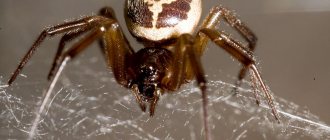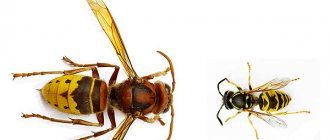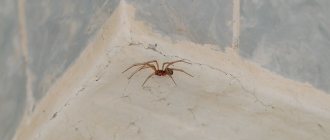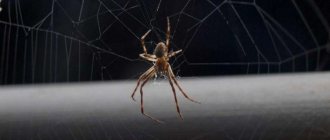Arachnophobia - fear of spiders and arachnids is one of the ten most “popular” phobias. The term itself comes from words from the Greek language: ἀράχνη - spider, ἀράχνη - horror. Arachnophobia is a special case of zoophobia, a broad category of anxiety disorders that target animal species. According to research by American psychologists, up to 50% of the female population of the United States experience panic fear of snakes, while the male population is only 10% susceptible to this phobia. At the same time, fear of spiders does not differ by gender, and the percentage of those susceptible to fear of arachnids significantly exceeds the fear of dogs and snakes.
Arachnophobia is a pathological, uncontrollable, progressive fear of spiders and any arachnids - scorpions, harvestmen and others.
Patients susceptible to arachnophobia experience a feeling of fear or severe panic not only upon contact with the object of the phobia (visual, tactile), but also upon mention of it: they may be frightened by stories about arachnids, watching television programs about these animals, as well as the sight of dead arachnids, their webs , photographs with their image. It is enough to simply hint to such a person that a spider has appeared in the room for him to have an attack of hysterics. Patients begin to scream in panic, climb onto chairs and other heights, and strive to leave the room - their fear is so strong.
How to get rid of arachnophobia
Drug treatment for spider phobia is extremely rare.
The most commonly used psychotherapy techniques are neurolinguistic programming, hypnosis, cognitive behavioral psychotherapy, and gestalt therapy. Three technologies that help overcome fears are especially popular:
- For prepared clients and strictly under the supervision of a psychologist, confrontational psychotherapy (gradual rapprochement with the object of fear) will help get rid of fear.
- Virtual reality is an innovation in the world of psychology. The client is offered to look at the insect, stroke it in the virtual world, or fight and defeat the insect by playing a game. This will allow you to stop being afraid of the insect and realize the irrationality of fear.
- To overcome deep psychological traumas, you will need psychoanalysis. You need to start the fight by transferring the problem from the subconscious to the level of consciousness. In the future, to overcome your fear, you can use other methods of psychotherapy, for example, hypnosis or those that have already been discussed.
In the initial stages, you can overcome arachnophobia on your own. For example, you can study literature. Find out the habits, lifestyle, structure of insects. As you study, you will realize that they are not dangerous for you.
We invite you to get acquainted with some more exercises that you can do yourself.
Exercise “Moving away from fear”
There are several methods of detachment, but they are all based on the same principle - reducing the significance of the object of fear, separating oneself from fear and anxiety. And imagination will help with this. Why is it? Because it invents danger, increases the size of the spider or brings it closer to you.
So, how to get rid of arachnophobia using dissociation:
- Mentally imagine the change in scale. Here the spider is in the next room, but on the street behind the glass. Now imagine looking at it through a telescope. Does this bug still scare you?
- Mentally change the time. As soon as you feel that anxiety is overpowering you, try to remember and feel what you experience in a state of rest when the attack lets you go. Imagine this happening now.
- Change reality. You can change the colors of the surrounding world, for example, replace them with black and white. You can change the color, size and brightness. Moreover, not only the entire picture, but also individual characters. For example, the same spider. Imagine how you shrink a spider. How it fades and disappears.
This is interesting! In some countries, spiders are a delicacy. If you have such an opportunity and are determined enough, you can literally eat your fear. At this time, imagine how you will get rid of it forever.
Exercise "Killing a Spider"
What to do if a child is afraid of spiders? Offer him this exercise. This is a version of art therapy.
How to combat arachnophobia with the “Spider Killing” exercise:
- Make a figurine of a spider out of plasticine that is as similar as possible to the insect that usually scares you. Try to repeat the color and size. Or sculpt it the way you imagine your fear.
- Take five minutes to examine your fear in detail. Remember all the emotions and feelings, thoughts, your state. Combine them and the figurine into one whole.
- Destroy your fear. Crush him or rip his head off.
You can replace modeling with drawing. In both cases, you can supplement the exercise with visualization of how you overcome fear. Sculpt or draw yourself dealing with fear.
It is important! The art therapy method is more suitable for children, but adults can also use it. Especially creative people.
Behavioral psychology
Behavioral psychology suggests fighting fear with behavioral psychotherapy. Under the supervision of a psychologist, the client approaches the object of fear. He tries to interact with him. In case of beginning panic, the psychologist tells you how to relax and calm down. The rapprochement begins with viewing pictures, photos, films. Later, the psychologist offers to look at the spider in the cage, the final stage is to take the spider in your hands and stroke it. At each stage, the specialist tells you how to overcome fear.
It is important! Treatment is selected individually in each case. A psychologist assesses the severity of a phobia of spiders and the client’s life history
If necessary, conducts testing and finds the root cause of fear.
How to deal with arachnophobia?
The panic fear of an arthropod in an adult cannot be ignored. It can develop into more serious pathologies - schizophrenia, or provoke a heart attack or stroke. You can try to overcome fear on your own; if there are no successful results, you should contact a psychologist. How to get rid of arachnophobia and control your emotions of groundless fear:
- Find the reason that provoked the phobia.
- Study the way of life of an arthropod, find out more information about it, that it does not attack humans, learn about species that are dangerous to health (most of which are on the verge of extinction and are listed in the Red Book), a spider bite is a method of defense and not attack.
- Visit the terrarium.
- Play a computer game - kill spiders, destroying your own fear.
How to cure arachnophobia?
Psychologists note that the fear of spiders is developed among people in those regions where there are no poisonous or dangerous species. It is very difficult to encounter a tarantula in a large metropolis of a multi-storey building or a neatly tidied office, but fear is widespread among city residents. In traditional cuisines of different nations, dishes are prepared from insects; even the real story of an insect bite does not cause phobia in such people. Arachnophobia is a disease that experienced psychologists treat in several sessions. The most effective method is called “behavioral therapy” - you need to approach fear in stages:
- State the reason for the fear.
- Observe the insect from afar.
- Approach him a short distance.
- Get close and examine (try to stroke).
How to stop being afraid of spiders at home
There is another way to regain a comfortable state when you find a spider in your home - this is to show feelings for it. People with the visual vector have a special talent for making friends, talking mentally with everyone in the world: insects, plants, animals, people.
1. Save the spider. I am big and strong, and he is small and defenseless. 2. Give the spider a name. When you find a spider, say: Hello, Petya! 3. Thanks, friend! Thank the house spider for the web where it caught mosquitoes and flies living in the apartment. 4. Books about little insects. These could be stories by V. Bianki, M. Prishvin and D. Mamin-Sibiryak. Tales about the mutual assistance of insects are perceived without fear. 5. Fairy tale. People with a visual vector have a rich imagination, and they themselves are able to come up with a good story that can become psychotherapeutic.
If you are aware of your psyche, you will no longer need such tricks.
Causes of pathology
Research conducted by doctors M. C. Jones and R. G. Menzies refuted the thesis that a person can always understand the reason for his fear of any object or phenomenon.
People suffering from arachnophobia usually do not understand why the pathology arose.
However, we were able to compile a list of reasons that can cause fear of spiders:
- Personal experience. Most often, arachnophobia has its roots in childhood. In 1996, a study was conducted in Holland that showed that 46% of children under ten years of age were always afraid of spiders. 41% of respondents reported that fear arose after a collision with a spider. Moreover, the answers received were confirmed by the relatives of the children who participated in the study. Thus, the hypothesis that arachnophobia arises regardless of the individual’s actual experience was refuted.
- Genetic factor. It is believed that arachnophobia may well be enshrined in human genes. Fear of potentially poisonous arachnids developed evolutionarily, gradually turning into a tendency towards pathological horror.
- Heredity and congenital characteristics of the nervous system. People with a weak nervous system are more likely to suffer from various unmotivated fears. The data obtained by American researchers suggests that if the father or mother of a child has any phobias, then he himself runs the risk of suffering from neurotic fears in the future. It has been proven that the characteristics of responding to a stressful situation are inherited. In relatives, one can observe a similarity in the perception of stressors, the degree of fixation on negative experiences and a similar processing of emotions.
- Erroneous learning at an early age. A child always copies the behavior of significant adults. As a rule, the most significant are the father and mother. And if a close relative considers spiders dangerous and demonstrates his horror in front of them, then the child will also feel this anxiety. It has been proven that in children whose close relatives suffer from arachnophobia, the sight of arachnids increases their pulse rate and increases their blood pressure. If such signs are fixed at the reflex level, in the future a person may develop panic phobia.
- Factor of surprise. Many researchers believe that the pathology in question is mainly due to the fact that it appears quite unexpectedly for a person. The spider can literally appear out of nowhere, quickly descending on its web. And when the stimulus appears in such an unexpected way, a state close to shock may occur. The ability of spiders to move extremely quickly is also alarming: it may seem that the insect can quickly attack a person, but its behavior cannot be predicted.
- Cultural model of behavior. Arachnophobia is more common in some countries around the world than others. Therefore, there is a hypothesis that the horror of spiders is fixed among the inhabitants of some regions at the level of the cultural code. Residents of countries where spiders are eaten never suffer from arachnophobia. For them, arachnids represent ordinary food or even a tasty and very desirable delicacy.
Behavioral trait
Another factor that provokes fear of spiders is a behavioral feature. It has been noted that among residents of countries and regions where a large number of poisonous arthropods live, phobia is much more common than in other regions. This is due to the fact that people living in close proximity to dangerous insects are forced to behave more carefully in order to avoid a painful and sometimes fatal bite.
For what reasons can a phobia appear?
Arachnophobia is a fairly common disease, so the question of what the fear of spiders is called is of interest to many. This is due to the fact that the number of urban residents is growing every year, and, as is known, this part of the population, due to rare contact with arthropods, is not always able to assess the degree of danger.
The occurrence of any phobia is preceded by certain events. Arachnophobia can develop in a person for several reasons:
- Unpleasant childhood memories of the first contact with an arthropod. Fear of spiders may appear due to an inadequate reaction of the parent to the sight of an arachnid. Many adults react with caution to arthropods, and also try to limit the child’s contact with any representatives of this class. As a result, the child develops a subconscious fear, which develops into a phobia with age.
- The second reason that may answer the question of why people are afraid of spiders is related to a person’s fear of contracting some viral disease. Due to the fact that many insects are capable of carrying various diseases, spiders are also considered a potential threat.
- If a person has previously been bitten by insects, then such an experience can leave a negative mark on the subconscious.
- Quite often, the sudden appearance of a spider can frighten even those who are calm about arthropods. Severe fear from such an encounter can also provoke spider phobia.
What are the dangers of arachnophobia?
Spider phobia can be dangerous for a person's psychological state and health. During attacks of fear, blood pressure rises sharply, the pulse quickens, which causes the heart to wear out faster.
If you have cardiovascular disease, a panic attack can cause a stroke or heart attack. Moreover, panic attacks can lead to ulcers, gastritis, heart disease, etc. The more a person is afraid of spiders, the more often such attacks occur.
Causes of arachnophobia
Many years of research have shown that people susceptible to arachnophobia are not aware of the irrational nature of their fears. Previously, most scientists believed that arachnophobes recognized the irrationality of their fears and were able to maintain some control over their fears. But it was later discovered that all arachnophobes are not fully aware of the nature of their fear, both in the presence of a spider and without it.
Studies conducted among children showed that although all the children tested were previously afraid of arthropods, their arachnophobia appeared as a result of a certain conditioning event.
From birth to adolescence, children focus their behavior on their parents and significant adults. Therefore, if one of the adults is susceptible to arachnophobia and considers arthropods dangerous and tries to avoid them, then there is a possibility that the child will experience the same fear, which will then control him. In such children, just looking at arthropods increases the pulse and heart rate. This theory can be confirmed by the observation that arachnophobia mainly spreads in certain areas.
There is also an opinion that the cause of arachnophobia may be the excessive danger of certain types of spiders, which contributed to the formation of such a phobia during the evolutionary development of an individual.
However, today there are a sufficient number of uncivilized peoples in whom such a phenomenon as arachnophobia is practically unknown. They even eat some varieties of arachnids. And in other cultures, arachnids are even worshiped.
Manifestations of arachnophobia should be differentiated from simple rejection of arachnids. Many consider them disgusting and disgusting, they try to shake them off, people are disgusted by touching the web, but this is just hostility, and not manifestations of arochnophobia.
Many physiologists and psychologists often explain the causes of arachnophobia by a significant difference in the structure of arachnids from humans. It is believed that the more different a living creature is from a person, the stronger the fear of it will be. However, this is not entirely true. There are many living organisms in the world that are significantly different from people, for example, jellyfish, but people do not experience panic fear of them.
The causes of arachnophobia are considered to be the suddenness, unpredictability of movements and the swiftness of spiders. Those. a person can notice them only when they are already in close proximity to his body. Also, the combination of a small body along with large legs and their number causes feelings of fear. The danger due to the poisonousness of spiders may also be one of the reasons for the development of arachnophobia. There is also a hypothesis that during the plague epidemic, arachnids were considered carriers of infection.
Arachnophobia and its causes are the filling of blue screens with films, the main genres of which are thrillers and horrors, where the acting “villains” are huge arachnids.
Modern biologists have proven that arachnids are a fairly ancient species of living organisms, which during the process of their evolution did not undergo any significant changes in size towards increase. On the contrary, in prehistoric times arthropods were much larger and much more dangerous. Therefore, today there are completely no facts on the basis of which it could be argued that in our time there could be an ancestor of giant-sized arachnids.
For the most part, spiders cause hostility and disgust in almost all people. Spiders today are saved from mass destruction by human superstitions, which consist in the fact that killing arachnids is considered a bad omen. Although in some beliefs it is believed that killing a spider removes 40 sins.
Increased impressionability
Impressionable people don’t even have to personally encounter arthropods to become afraid of them. All they have to do is listen to scary stories or watch enough movies about poisonous spiders.
Modern cinema often produces horror films about huge spiders that devour people. Even understanding that this is fiction and such creatures do not exist in the world, an impressionable person can develop a phobia after watching such films. Therefore, psychologists do not recommend that parents show their children such cinematic “masterpieces.”
Symptoms
Behavioral
Arachnophobes suffer from insomnia because they believe that in a dream a spider will climb into their ear, nose or even mouth and lay eggs with larvae there.
Which, naturally, is very frightening in itself, in addition to the likely health difficulties that will certainly be accompanied by acute pain.
And if you don’t sleep at night and don’t get enough sleep, your body will gradually become exhausted. After all, he spends colossal resources during the day. Anxiety alone only takes away most of the energy, let alone the work he does and other feelings.
In severe cases, they categorically refuse to leave their home, because it is unknown how much nasty stuff is hidden on the street, in the grass, in the entrances.
Hallucinations are sometimes observed. That is, a person thinks that he is being attacked by hordes of arthropods and is trying to fight them off and shake them off.
From the outside it looks like he has gone crazy. His behavior is frightening and poses a threat both to his life and health, and to those around him, whom he may accidentally offend at such a moment.
Somatic
During a panic attack, the phobe experiences tachycardia, nausea, dizziness, vomiting and increased blood pressure. Also pain in the stomach and chest. It looks like he's about to have a heart attack and die.
There is not enough air, so a person may suffocate in a moment of panic. Inhaling carbon dioxide, which we release as we exhale, will help us return to normal on our own.
The fact is that due to shallow and frequent breaths, the level of oxygen in the blood becomes excessively high, which causes asphyxia.
Place your palms on your face and breathe in them for a couple of minutes, this will help you calm down and get rid of dizziness, preventing loss of consciousness.
In addition to the above symptoms, tremors of the limbs and increased sweating are observed. An arachnophobe loses control over himself, so he usually tries to run away, throw off what he considers a dangerous animal, and kill it.
Naturally, his actions are accompanied by screams and crying. The voice trembles, breaks down, his hands are not able to hold the objects with which he tries to slam the animal.
He risks getting into an unpleasant situation when he tries to hide, because he is unable to adequately perceive the surrounding reality. For example, getting hit by a car, falling through a hatch, falling down a ladder, etc.
After the panic attack ends, the phobe experiences fatigue and shame, literally toxic. This only worsens the general condition and provokes further development of the disorder.
Clinical manifestations
The fear of spiders is called arachnophobia, the disease is manifested by a strong, painful fear, which leads to disorientation of the patient and such typical manifestations as autonomic disorders and panic attacks. Arachnophobia is a fear of spiders that occurs in the form of a panic disorder with periodic attacks, resulting in symptoms of intense fear combined with psychological and physical manifestations of anxiety.
A vegetative crisis (attack) is accompanied by a feeling of approaching death, strong anxiety about a possible loss of control over one’s behavior, and fear of fainting or insanity. The initiator of the attack is a real meeting with a representative of arachnids, less often, viewing images of spiders, or a mental representation of events involving arthropods.
Symptoms increase during the attack, reaching a maximum after about 10 minutes from the onset of the first symptoms, after which it slowly regresses over about 30-45 minutes. Patients experience fear of arachnids that provoke an attack, and of the panic attack itself, which is associated with a feeling of defenselessness and often with the inability to control their actions during this period.
A stable model of avoidant behavior is formed when the patient seeks to prevent situations in which a meeting with a provoking stimulus is possible. Anxiety-phobic disorders are often accompanied by the development of depression and other mental pathologies. In phobia syndrome there are always signs of autonomic dysfunction:
- Increased sweating.
- Rapid, shallow breathing, shortness of breath, feeling of lack of air.
- Dry mouth.
- Pain, feeling of constriction in the chest area.
- Tachycardia (rapid heartbeat).
- Nausea, discomfort in the epigastric area.
- Tremor of the limbs and other parts of the body (nervous tremors).
An arachnophobe is a person who, at the moment of a real or imaginary meeting with a representative of arachnids, experiences an attack of dizziness, confusion, and may faint. A person who is afraid of spiders is in constant anticipation of meeting them, carefully cleaning the room, examining all corners of the room for the presence of cobwebs and other traces of arachnids.
To avoid a possible encounter, the patient prefers to spend more time at home, rarely goes outside, and does not communicate with other people. Over time, arachnophobes become withdrawn, irritable, and aggressive. The fear of spiders is called arachnophobia, like any other phobia it is characterized by a tendency to transform into a chronic form. Cases of episodic manifestations are extremely rare.
Causes of fear of spiders
Detailed research by scientists refutes the previously generally accepted concept that arachnophobia, like other fears, is initially known to the individual due to its occurrence. Experts claim the existence of fear at the subconscious level, not only in the presence of arachnid creatures, but also far from their halo of habitat.
Often the fear of spiders is inherited from childhood. An interesting study was conducted in Holland (1996). It showed that almost 50% of surveyed children aged 6–10 years old experienced this fear. Moreover, in 40% it appeared after visual or tactile contact with arthropods. Most of the answers were confirmed by the parents of the children surveyed. The results cast doubt on the theory of the non-associative nature of the manifestation of phobia, delving more carefully into the learning experience.
Genetic and other prerequisites for arachnophobia
The instinct of self-preservation of the ancestors was partially transformed into a specific configuration. Some people have a subconscious feeling of anxiety in their gene code when encountering spiders.
The next reason is a hereditary-congenital change in the NS. Persons with this deviation are susceptible to various fears, including arachnophobia. The American Psychiatric University has found that the presence of obsessive fear in parents significantly increases the risk of various types of phobias in children.
Raising and training the younger generation also requires the right approach. If adults scare their offspring with insects or themselves show open fear of them, fear at the subconscious level persists into adulthood.
The activation of arachnophobia is often associated with the sudden appearance of an arthropod. For example, he suddenly hung on a spider's web from a branch in front of a tourist's eyes. A sudden “date” sometimes leads to a state of shock. Anxiety manifests itself as a result of the unpredictable behavior of an animal, which a person mistakes for attacking actions.
Another factor is behavioral trait. In areas where the habitat of various types of spiders has been historically recognized, arachnophobia manifests itself more often and more noticeably.
Prevention of arachnophobia in adults at home
Prevention of fear of spiders, as psychotherapist Sergei Prokin , like most other phobias, should begin in childhood. It includes various activities to strengthen physical and mental health, especially the functioning of the nervous system.
Equally important is the rational upbringing of children - without severe emotional stress, without the formation of constant anxiety, and avoiding overprotection. Parents should be involved in developing correct and age-appropriate social skills and independent decision-making.
Causes of fear of spiders
- There is an opinion that aversion to spiders is a consequence of evolutionary development
. Concern arose back in those days when a bite most likely led to death. During the period of the plague, spiders were considered one of the carriers of infection. At the same time, some uncivilized peoples do not have an aversion to arthropods as such - they are eaten. - A child can copy the behavior of adults
. When a child sees how his parents panic when a spider appears, the idea is fixed in his mind that he is dangerous and should beware. Therefore, most people acquire a phobia in childhood, and find it difficult to say exactly at what point it was formed. - Anxiety can develop due to watching a feature film or documentary
in which the hero is seriously injured or died from an arthropod bite. - Fear is often provoked by the fact that arthropods have the ability to move quickly and appear suddenly. Each of us has at least once found a spider unexpectedly in our home - for example, in a dark corner in the bathroom. In addition, all arachnophobes consider these insects extremely unattractive and disgusting. Mainly, the large number of legs in spiders causes disgust.
Treatment
Behavioral therapy is considered the most effective in treating arachnophobia. Its essence lies in the fact that the arachnophobe, with his consent, is brought closer and subsequently confronted directly with the cause of his fear - the spider. This process occurs gradually, starting with small spiders and ending with tarantula spiders. If the subject is able to overcome his phobia, then a cure for the disease occurs. If the patient continues to avoid sources of fear, the phobia intensifies even more.
Many people who suffered from arachnophobia in the past now keep arachnids in their homes, which is an overcompensation. Overcompensation is one of the psychological defense mechanisms, the implementation of which completely gets rid of arachnophobia and feelings of inferiority and achieves a result that allows you to take a leading position in relation to others.
Another method of getting rid of arachnophobia is specially developed computer programs that simulate situations of collision with arachnids in virtual reality and can be corrected by the subject’s behavior.
In the course of ongoing research, Spanish and American scientists have found that therapy for arachnophobia using virtual reality will be twice as effective if the patient touches a computer monitor during the treatment session.
Another popular method of treating arachnophobia is the graphic method, in which the subject suffering from this type of phobia is tasked with reproducing the object of his fear on paper. In the first drawings, the arachnids will be depicted as very scary and large. They should be destroyed. As they heal, the spiders in the pictures will decrease in size and become cuter, if such a concept applies to arthropods. This treatment should continue until the individual is completely cured and no longer has any fear of spiders.
How to overcome arachnophobia on your own? Arachnophobia is one of the most common types of phobias, therefore it should be dealt with in the same way as with other types. First, you need to master some methods of meditation and relaxation techniques that will help distract a person from focusing on obsessive fear. You should also prohibit yourself from discussing the manifestations and symptoms of arachnophobia with other people. You need to take responsibility for your fear, overcome yourself and force yourself to touch the cause of the phobia - the spider.
Every individual should know that panic fear of arachnids can be quite easily instilled in oneself. Therefore, to prevent this from happening, you need to learn to control your phobias.
How to overcome arachnophobia? Why conquer it? It’s better not to let your fears develop into a phobia. Therefore, you should always remember that it is not fear that controls and controls people, but people by it.
You should also know that arthropods pose a serious and real danger only to those people who live in regions with a warmer climate. Arachnids will never attack humans purposefully. Therefore, the easiest way to deal with the fear of spiders is sometimes just behavior in which a person simply does not pay any attention to them.
We are on Telegram! Subscribe and be the first to know about new publications!
Statistics and paradoxes
Arachnophobia is one of the most unusual and common types of fear. Statistically, it surpasses the fear of air travel and firearms, and is also relatively close on the “horror” scale to the fear of cars and car accidents.
At the same time, it is not entirely ordinary and is accompanied by various paradoxes. For example, if you live in a region where the fauna is abundant with insects and arachnids, then the risk of developing a phobia is minimal, but the fear of spiders can become chronic. The only difference will be that when you see the object of fear, you will not panic.
But there are still areas on the planet where spiders are part of the diet of the aborigines, almost like potatoes or chicken eggs. The most that locals here can fear regarding spiders is chibophobia (fear of food in general) or mageirocophobia (fear of cooking).
What are the reasons for fear?
There are many factors that can cause a fear of spiders. They are listed in the table.
| Name | Description |
| Regional disorder | For example, if a person lives in an urban area and rarely sees spiders, he may develop arachnophobia. Or, conversely, in some regions there are many such insects, and they are all large in size, so people can develop the disease |
| Fear passed down from our ancestors | The point concerns situations where the disease appears from an early age. For ancient people, spiders posed a danger because of their poisonousness, so an encounter with an animal earlier could have resulted in death. Some people may inherit this fear. |
| Bite | May be a consequence of the onset of a disease. Additionally, there is a fear of contracting an infection. |
| Example of parents or loved ones | The symptom can cause the development of the disease in childhood. If help is not provided in time, the child will remain afraid of spiders all his life. |
| Physical disgust | The insect cannot be called pleasant. Many people don't like cockroaches and spiders, so they have minimal contact with them. Some people are particularly frightened by the eyes. |
| Disinformation | A person may be afraid of spiders due to misinformation. For example, someone said that they are poisonous. This point is not true, because most spiders do not cause any harm to humans. |
| Horror | This item does not include positive films (Spider-Man and others). There is little sympathy for the spiders in Harry Potter, The Lord of the Rings. |
| Famous TV shows | Some projects test people's strength. For example, in Ford Boyard you had to go into a room with a lot of spiders and complete a task. |
Diagnostics
For arachnophobia, treatment begins with determining the cause of the development of fear. It is almost impossible to do this on your own in the vast majority of cases, so it is recommended to consult a psychotherapist. The diagnosis is made quickly enough based on the information obtained by the doctor during a conversation with the patient.
At the same time, the psychotherapist asks a series of questions and conducts several tests to rule out other mental disorders. Based on the information received, the doctor will be able to immediately tell the patient how to treat arachnophobia.
The cost of an initial consultation is from 500 to 1000 rubles. The exact cost should be found out directly at the selected clinic, as it depends on the region of residence and the qualifications of the doctor. The price of further treatment is determined individually - depending on how the doctor proposes to get rid of spider phobia (arachnophobia).
Consequences
An untreated phobia brings significant inconvenience to the patient’s life. In some cases it leads to extremely negative results:
being in constant tension and fear, the patient becomes extremely irritable; hopelessness, according to the individual, of the situation leads to depression; the anticipation of an arachnid invasion forces patients to mobilize even at night, which is why arachnophobes often suffer from insomnia. As a result of lack of sleep, they experience constant fatigue, loss of strength, and decreased performance; the fear of encountering an insect forces one to sharply limit social activity. A person refuses to attend many events – entertainment, necessary for professional activities
Even going out to buy groceries becomes problematic; in severe cases, attention gets stuck exclusively on the subject of the phobia, forcing you to remain in a state of combat readiness, not allowing you to relax. Then the patient forgets to carry out basic procedures - eat, maintain hygiene
He loses weight, becomes exhausted, exhausted; an extreme degree of disorder leads to a change in consciousness. Hallucinations appear, a change in consciousness such as oneiroid or delirium is possible. The patient thinks that the house is filled with spiders. They attack him from all sides, jumping on his face, body, and limbs. The arachnophobe is in horror and panic. The condition is like death throes.
Trying to overcome your fear on your own, you need to clearly understand the boundaries of the norm. If there is no effect from self-medication, you must seek qualified help.











